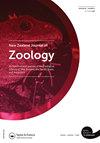Genomic evidence of a functional RH2 opsin in New Zealand parrots and implications for pest control
IF 1.1
4区 生物学
Q3 ZOOLOGY
引用次数: 0
Abstract
ABSTRACT Recent genomic evidence suggest that kea (Nestor notabilis) have a non-functional RH2 opsin gene potentially leading to impaired vision in the green region of the electromagnetic spectrum. In New Zealand, it is standard procedure to add green dye to aerial poison baits used in mammalian predator control operations to deter native birds from eating toxic bait. A visual deficiency could impact how kea perceive and interact with green-dyed baits and thus have unforeseen consequences for kea conservation. Here, we sequenced the partial RH2 gene of seven wild kea and re-analysed the kea genome raw sequencing data of the RH2 locus. We demonstrate that the reported premature stop codon is most likely an assembly artefact. An extended analysis of the published genomes of all three extant New Zealand parrots of the superfamily Strigopoidea confirms that the RH2 gene is functional in this entire group.新西兰鹦鹉RH2视蛋白功能的基因组证据及其对害虫防治的影响
摘要最近的基因组证据表明,kea(Nestor notabilis)具有一个非功能性RH2视蛋白基因,可能导致电磁波谱绿色区域的视力受损。在新西兰,在哺乳动物捕食者控制行动中使用的空中毒饵中添加绿色染料是阻止本地鸟类食用有毒诱饵的标准程序。视觉缺陷可能会影响kea对绿色诱饵的感知和互动,从而对kea的保护产生不可预见的后果。在这里,我们对7个野生kea的部分RH2基因进行了测序,并重新分析了RH2基因座的kea基因组原始测序数据。我们证明,报道的过早终止密码子很可能是一种组装伪像。对Strigopoidea超科所有三种现存新西兰鹦鹉的已发表基因组进行的扩展分析证实,RH2基因在整个群体中具有功能。
本文章由计算机程序翻译,如有差异,请以英文原文为准。
求助全文
约1分钟内获得全文
求助全文
来源期刊
CiteScore
2.80
自引率
0.00%
发文量
20
审稿时长
>12 weeks
期刊介绍:
Aims: The diversity of the fauna of the southern continents and oceans is of worldwide interest to researchers in universities, museums, and other centres. The New Zealand Journal of Zoology plays an important role in disseminating information on field-based, experimental, and theoretical research on the zoology of the region.

 求助内容:
求助内容: 应助结果提醒方式:
应助结果提醒方式:


